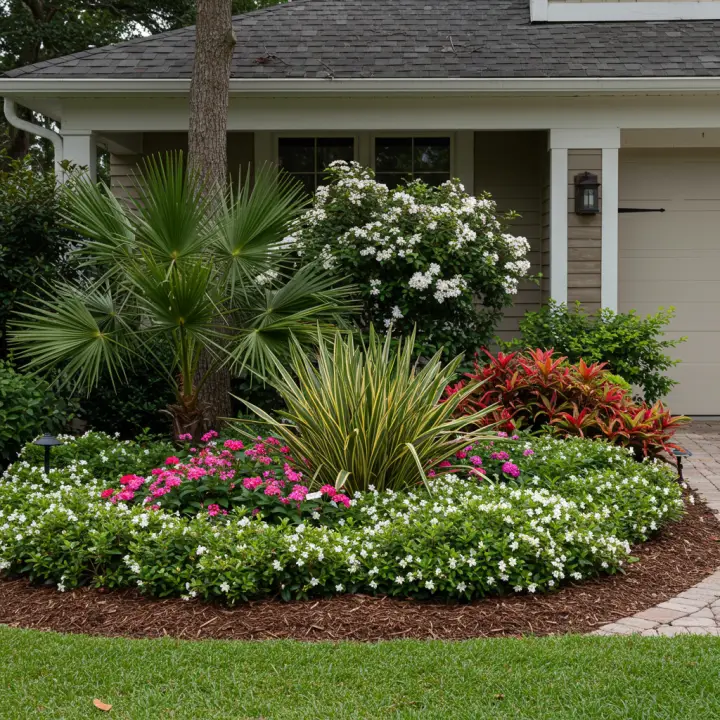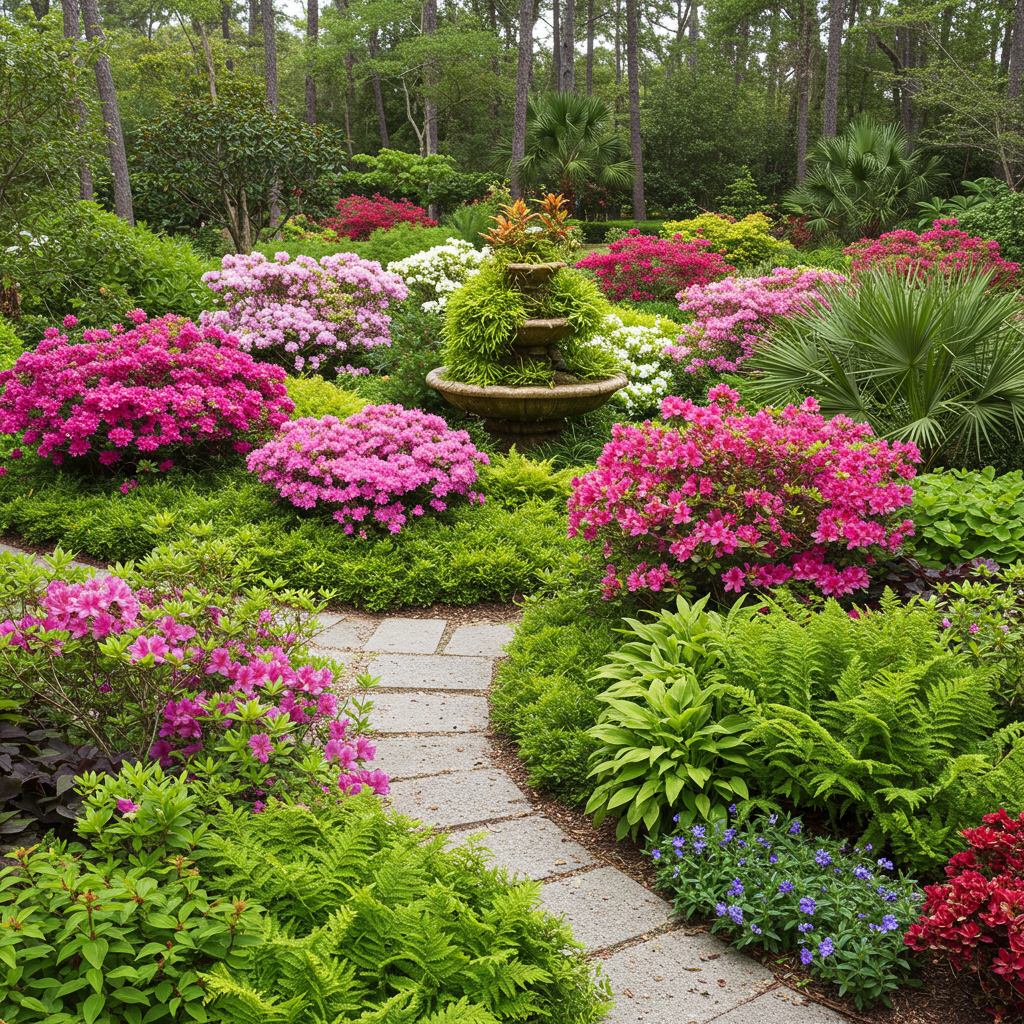Transform your outdoor space with the best landscaping plants for NE Florida! This guide provides top picks, essential considerations, and expert tips to create a beautiful, thriving landscape, perfectly suited for the region’s climate.
Northeast Florida offers a unique climate – warm, humid summers, mild winters, and sandy soil – which means selecting the right plants is crucial for a stunning and sustainable landscape. Choosing plants specifically adapted to this environment not only ensures their survival but also reduces the effort and resources needed for their care. Dive into our comprehensive guide to discover the ideal flora to make your NE Florida garden flourish.

Understanding NE Florida’s Unique Climate and Soil
Before you start digging, it’s vital to grasp what makes gardening in NE Florida distinct. This region typically falls within USDA Plant Hardiness Zones 9a and 9b, meaning plants should tolerate occasional winter frosts but also thrive in intense summer heat and humidity. Most soil here is sandy, which drains quickly and often lacks organic matter, necessitating specific plant choices and soil amendments.
USDA Hardiness Zone: Primarily 9a and 9b.
Dominant Soil Type: Sandy, well-draining, often low in nutrients.
Climate Challenges: High humidity, intense summer heat, occasional winter freezes.
Essential Considerations for Plant Selection
To ensure your landscape thrives with minimal fuss, keep these factors in mind when selecting your landscaping plants for NE Florida:
Sunlight Exposure: Observe your yard throughout the day. Does an area receive full sun (6+ hours), partial sun (4-6 hours), or full shade (less than 4 hours)?
Water Needs: Group plants with similar watering requirements together. This conserves water and prevents over or under-watering.
Mature Size: Account for the plant’s ultimate height and width. Don’t plant too close to structures or other plants.
Pest and Disease Resistance: Opt for varieties known to resist common local pests and diseases to minimize chemical use.
Native vs. Adaptive:
Native Plants: Naturally evolved in the region, they are perfectly suited to the climate, soil, and local wildlife, often requiring less water and fertilizer.
Adaptive Plants: Non-native species that have proven to perform well in NE Florida with minimal care, offering a broader range of aesthetics.
Top Picks: Best Landscaping Plants for NE Florida
Here are some of the most reliable and beautiful plants that will thrive in your NE Florida landscape:
1. Evergreen Shrubs (Year-Round Structure and Greenery)
Evergreen shrubs provide crucial structure and privacy throughout the year.
Podocarpus (Podocarpus macrophyllus): A versatile, upright evergreen that can be hedged, left natural, or even trained as a small tree. Very low maintenance and drought-tolerant once established.
Loropetalum (Loropetalum chinense): Features beautiful burgundy foliage and vibrant pink fringe-like flowers in spring. Various sizes available from dwarf to tall.
Indian Hawthorn (Rhaphiolepis indica): Attractive dark green foliage, white to pink flowers in spring, and small berries. Excellent for hedges or foundation plantings.
Dwarf Yaupon Holly (Ilex vomitoria ‘Nana’): A compact, native evergreen. Perfect for borders, low hedges, or mass plantings. Drought-tolerant and hardy.
Azaleas (Rhododendron spp.): Many varieties, especially the native Florida azaleas and popular Satsukis, thrive in partial shade with well-draining, acidic soil, offering spectacular spring blooms.
2. Flowering Perennials (Continuous Color and Pollinator Support)
Bring vibrant color to your garden with these repeat bloomers.
Lantana (Lantana camara): Extremely tough, drought-tolerant, and produces clusters of colorful flowers (yellow, orange, pink, purple) from spring through fall. A magnet for butterflies.
Pentas (Pentas lanceolata): Often called Egyptian Starcluster, Pentas offers continuous star-shaped blooms in shades of pink, red, purple, and white. Another butterfly favorite.
Coreopsis (Coreopsis leavenworthii – native): Sunshine-yellow, daisy-like flowers. Very resilient and excellent for naturalizing or meadow-style gardens.
Salvia (Salvia spp.): Many varieties, including ‘Mystic Spires Blue’ and ‘Wendy’s Wish’, provide long-lasting spikes of blue, purple, red, or pink flowers that attract hummingbirds.
Gaillardia (Gaillardia pulchella – native): Also known as Blanket Flower, this native perennial features cheerful red and yellow daisy-like flowers. Very drought-tolerant and thrives in full sun.
3. Small to Medium Trees (Shade and Focal Points)
Add height and impact with these suitable tree choices.
Crape Myrtle (Lagerstroemia indica): A classic Southern tree, offering stunning summer blooms in various colors, attractive bark, and diverse sizes. Tolerates heat and drought.
Southern Live Oak (Quercus virginiana – native): While growing large, a young Live Oak is an iconic NE Florida choice, providing long-term shade and ecological value. Plant thoughtfully with space in mind.
Dwarf Magnolia ‘Little Gem’ (Magnolia grandiflora ‘Little Gem’): A compact version of the majestic Southern Magnolia, featuring glossy evergreen leaves and fragrant white flowers.
Red Maple (Acer rubrum – native): A fast-growing native tree providing shade and beautiful fall foliage, though less intense than northern varieties. Tolerates varied soil.
4. Groundcovers & Ornamental Grasses (Texture and Erosion Control)
These plants add texture, suppress weeds, and can help with erosion.
Liriope (Liriope muscari): Also known as Monkey Grass, this is a tough, low-maintenance evergreen groundcover with grass-like foliage and purple flower spikes.
Muhly Grass (Muhlenbergia capillaris – native): Stunning native ornamental grass known for its airy, cloud-like pink or purple plumes in the fall. Drought-tolerant.
Coontie (Zamia integrifolia – native): A Florida native cycad, offering a prehistoric look with stiff, palm-like fronds. Extremely drought-tolerant and great for shady spots.
Dwarf Aztec Grass (Ophiopogon japonicus ‘Nana’): A finer-textured alternative to liriope, excellent for borders or mass plantings in partial to full shade.
5. Palms (The Iconic Florida Touch)
No NE Florida landscape is complete without a few hardy palm trees.
Sabal Palm (Sabal palmetto – native): Florida’s state tree. Extremely cold-hardy and drought-tolerant once established. Provides classic tropical flair.
Dwarf Palmetto (Sabal minor – native): A compact, clumping palm perfect for smaller spaces or understory planting, tolerating shade and very cold-hardy.
Windmill Palm (Trachycarpus fortunei): Known for its exceptional cold hardiness, making it a reliable choice for the cooler end of NE Florida.
Designing Your NE Florida Oasis
Creating a beautiful landscape involves more than just selecting plants; it’s about thoughtful design.
Layering: Arrange plants by height, with taller specimens in the back, medium ones in the middle, and shorter plants or groundcovers in the front.
Mass Planting: Planting groups of the same species creates a cohesive and impactful visual statement.
Water-Wise Landscaping (Xeriscaping): Group plants with similar water needs to optimize irrigation and conserve water. Choose drought-tolerant species.
Attract Local Wildlife: Incorporate plants that provide nectar, host food, or shelter for birds, butterflies, and other beneficial creatures.
Quick Care Tips for Your New Landscape:
Watering: Water newly planted specimens deeply and regularly until established (typically 6-12 months). Afterward, adjust based on plant needs and rainfall.
Mulching: Apply a 2-4 inch layer of organic mulch (pine bark, pine straw, or shredded cypress) to conserve moisture, regulate soil temperature, and suppress weeds.
Fertilization: Perform a soil test to determine specific nutrient needs. Many native and well-adapted plants require minimal fertilization.
* Pruning: Prune to maintain shape, remove dead or diseased branches, and encourage fuller growth.
Frequently Asked Questions About Landscaping Plants in NE Florida
Q1: What USDA Hardiness Zone is Northeast Florida?
A1: Northeast Florida primarily falls into USDA Plant Hardiness Zones 9a and 9b. This means plants should be able to withstand minimum winter temperatures between 20°F and 30°F.
Q2: Are native plants always the best choice for NE Florida?
A2: Native plants are often an excellent choice because they are naturally adapted to the local climate, soil, and ecosystem. They typically require less water, fertilizer, and pest control. However, many non-native, “adaptive” plants also thrive here with minimal care and expand your design options.
Q3: How often should I water new plants in my NE Florida landscape?
A3: For the first 6-12 months after planting, consistent deep watering is crucial for establishment. Water new plants every 2-3 days, or more frequently during hot, dry periods, checking that the soil is moist but not waterlogged. Once established, most adapted plants will need less frequent watering.
Q4: What are some drought-tolerant plants for NE Florida?
A4: Many plants thrive in NE Florida’s dry periods once established. Great drought-tolerant options include Lantana, Coreopsis, Gaillardia, Muhly Grass, Coontie, Podocarpus, and Sabal Palms.
Q5: Can I grow citrus trees successfully in NE Florida?
A5: Yes, many citrus varieties can be grown in NE Florida, especially in Zone 9b and with some winter protection in Zone 9a. Popular choices include Satsumas, Kumquats, and some varieties of Oranges and Lemons. Choose cold-hardy rootstocks and consider protection during hard freezes.
Conclusion
Creating a beautiful and sustainable landscape in Northeast Florida is an enjoyable and rewarding endeavor. By understanding your local climate, making thoughtful plant selections from our top picks, and implementing smart design and care practices, you can cultivate a vibrant outdoor space that flourishes year-round. Embrace the unique beauty of Florida’s flora and transform your yard into a personal oasis with the right landscaping plants for NE Florida!

